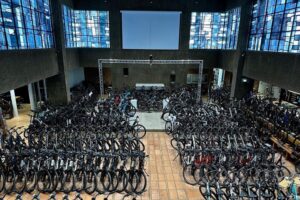
Seven years before the terrace of houses he built was burnt to the ground, Paddy Byrne’s helicopter crashed in a hotel carpark.
The events were unrelated, but together gave a rare glimpse of a Celtic Tiger developer, who he was, what became of his work.
He has flitted in and out of the headlines since. There he is, emerging from his bankruptcy. Is that the same Paddy Byrne who built the dangerous homes in Newbridge, now back in business with another company?
Listen to the bankruptcy official in the UK describing him as trying to “cheat creditors”.
Down in the courts earlier this year there was a liquidator claiming that Mr Byrne was ducking and diving, buying a hugely expensive vehicle for himself while creditors whistled Dixie.
And now, the latest incarnation of the extraordinary Mr Byrne.
He is currently in dispute with South Dublin County Council over attempting to develop modular homes on a site that has never received full planning permission, in an area in which the zoning is so restrictive it is all but impossible to get any kind of permission.
Paddy Byrne, in his third known developer incarnation, is engaged in work on a site in Brittas Bay with his current vehicle, Branach. Controversy centres on the status of the site he is developing.
He has even taken the highly unusual move of writing a personal appeal to elected councillors to allow him to carry on.
So it goes in the various incarnations of a Celtic Tiger developer who, in many ways, summed up the times back then and, in other ways, continues to do so today.
Byrne was one of a whole clutch of developers who got rich during the time of plenty in this country in the early years of the new century.
If you had any kind of a background in construction, the semblance of a business head on you, and a sackful of ambition, the Tiger was your oyster.
He was born in 1969, reared in Thomastown, outside Naas, and began his working life as a roofer. In the 1990s, he began working for himself, developing sites. In 2001, his main corporate vehicle, Barrack Homes, was set up.
He worked across the country, but mainly in the Leinster area. Pretty quickly, Mr Byrne was rolling in it.
He bought a mansion in Athgarvan in rural Kildare. He acquired the must-have toy for Tiger developers — a helicopter.
He was a feature at major race meetings, and his company sponsored the Pat Taaffe Handicap Steeplechase at the Irish National Hunt Festival in 2007.
The following year, Byrne came to public attention, really for the first time, when his €2.4m Sikorsky helicopter crashed in the carpark of a hotel near Bettystown in Co Meath.
Four people were reportedly hurt, but nobody sustained life-threatening injuries.
By then, the dark economic clouds were gathering on the horizon.
Byrne was also, at that time, constructing a full estate of timber-framed houses and apartments in Newbridge, Co Kildare.
Millfield Manor was a mixed development of two- and three-storey townhouses and apartment blocks.
Most of the homes were sold at a time when the Tiger was still at a gallop.
The ‘Irish Examiner’ report on September 19, 2008, of the crash the previous day at Bettystown Co Meath of a helicopter owned by Paddy Byrne’s company, Barrack Construction Ltd.
But before the full estate could be offloaded, the squeeze was put on Byrne, as it was on so many in the same business at the time.
He ended up declaring bankruptcy in the UK in 2011, with debts approaching €100m.
The UK at the time was a favoured destination for those declaring bankruptcy, as it was legally possible to emerge from the process within one year, while in this country the term was 12 years.
Byrne did not get out of his bankruptcy at the earliest legal opportunity.
The insolvency service overseeing it accused him of an attempt to “cheat creditors” through engaging in “several transfers from his personal account at the National Irish Bank to relatives and associates in informal and unwritten arrangements which, because of their undocumented nature, were impossible to prove”.
He found himself, as such, spending a longer period exiled in the UK than he had bargained for.
Meanwhile, back home, the bitter fruits of Byrne’s work were being manifested.
On March 31, 2015, a fire razed a terrace of six houses in Millfield Manor in less than half an hour.
Thankfully, the fire occurred in the afternoon, when very few people were in the homes, and they were evacuated relatively easily.
But the fire should have taken at least three hours to do the damage that was done in half an hour.
Immediately, Kildare County Council opened an inquiry into what had happened and whether the other residents were in any further danger.
A report pointed out a whole range of fire-safety defects in the estate, which rendered the homes extremely dangerous in the event of a fire breaking out.
The owners attempted to get help from the local authority, which pointed to Paddy Byrne as the developer.
The scene after the fire at Millford Manor in Newbridge, Co Kildare, in 2015, when a terrace of six houses was razed in less than half an hour, prompting the opening of an inquiry by Kildare County Council and a report which pointed out a whole range of fire-safety defects.
One estimate was that remedial work would cost €15,000 for each home.
A further complication was that each individual homeowner could only make their home safe if their immediate neighbours on each side did likewise.
They lobbied politicians. They attempted to make Mr Byrne accountable, but his company was no more. They were left high and dry.
While Mr Byrne has what is often referred to as a colourful history, so too has the site that he is currently working on.
In 1969, 16 mobile homes and six chalets were installed on a site in Raheen, near Brittas, Co Wicklow.
The owner of the site, David Hill, did not obtain any planning permission for this development. It was called Chianti Park, giving it an exotic flavour of the hills of Tuscany.
There was, at the time, some controversy locally about the development.
The result was that, in August 1972, the parliamentary secretary for the minister for local government (what would today be a junior minister) granted planning permission, as was within his power.
By today’s standards, such power invested in a politician might seem to be from another world, but that’s the way it was. The permission, however, came with the stipulation that the mobile homes should be removed within one year.
This didn’t happen.
Neither did Dublin County Council (as it then was) seek to enforce the condition of planning.
At least not until 16 years later when, in April 1988, Mr Hill was instructed by the council to remove what was an unauthorised development.
The matter was unresolved and ended up in the High Court, which issued a decision four years later, in March 1992.
In it, the court pointed out that the planning act of 1963 required that the council must, within five years of an unauthorised structure being in place, “serve the enforcement notice on the owner”.
It went on: “The date for that would have expired in 1978, that is five years after the year within which the condition was to apply.”
The judgement concluded by expressing “dismay that in a proceeding where a condition was attached that was to end after one year, Dublin County Council should do nothing for 15 years, and in that sense both allow the defendant to assume that it was all right to continue and not to enforce the planning condition which it itself had granted.”
That was a theme that would be, and even continues to be, repeated ad nauseam from the bench in cases of planning enforcement by local authorities across the State.
The High Court ruling was appealed to the Supreme Court by the council, but the appeal failed.
As a result, Chianti Park was to be left as it had been constructed, despite not having any planning permission.
The park continued to be inhabited by various tenants up until around 2015. Thereafter, it lay idle until earlier this year, when who should come calling but our old friend, Mr Paddy Byrne?
The intervening years had seen Mr Byrne’s fortunes rise and fall. His bankruptcy in the UK was extended because of what the insolvency service saw as his failure to co-operate fully.
In 2018, he was back in business, running a company called Victoria Homes. His new vehicle survived the pandemic, but not by much.
In April 2024, a liquidator was appointed to the business on foot of a debt of €447,000.
In August this year, the matter was before the High Court again, and in an echo of what had occurred during Byrne’s UK bankruptcy, the liquidator was having difficulty in sifting through the debts.
The court was told by liquidator Aidan Garcia that he was aware that Byrne’s mansion in Co Kildare had been put up for sale with a price tag of €2.75m.
“I have a considerable concern that the funds realised therefrom will be dissipated and put beyond the reach of me, as liquidator, and the company’s creditors,” he said.
Among the issues he raised were:
A “complete absence of accounting records after 2019”. The company had continued to trade after April 2020, a time after which it was unable to pay its debts. This was “reckless”;
Byrne, the main director, owed his company €294,000;
He had “failed to disclose a mortgage-free property in Holyhead, north Wales, worth approximately £76,000. He claimed this was “an oversight”;
In May 2022, at a time when the company could not pay its debts, Byrne had purchased a Range Rover for a sum of €72,000;
He had also taken €80,000 from the company “in lieu of rent” he said was owed to his mother;
He paid out €36,000 for an alleged corporate event in a gun club in Co Kildare.
Byrne disputed many of these issues, but Garcia noted he didn’t produce any evidence to back up his contentions, and in the case of the Range Rover, changed his story.
The liquidator applied for a freeze on funds to be realised from the sale of the mansion. The judge agreed to the stay, to the value of €600,000.
Three days later, the case was again before the High Court. Following undertakings given by Byrne and accepted by the liquidator, the freezing order was lifted.
Now in his third known developer incarnation, Byrne is engaged in work on the site in Brittas Bay.
After Barrack Homes and Victoria Homes, his current vehicle is Branach. And controversy is following him again, this time centred on the status of the site he is developing.
South Dublin County Council is seeking an interim injunction to stop Byrne’s company building modular homes on the site.
Mr Byrne has personally written to councillors, pleading his case, and addressing a rumour that the site would be used for housing international protection applicants.
“No agreement, proposal, or application exists to accommodate Ipas residents or to use the site for any form of refuge or State-directed housing,” he wrote.
A spokesperson for An Garda Síochána confirmed to the Irish Examiner that there was a fire, treated as “an incident of criminal damage” at the site on October 5.
“A technical examination has since been conducted by the Divisional Scenes of Crime Unit, and investigations are ongoing,” the spokesperson said.
Elsewhere, in the letter to the councillors, Byrne claimed that the proposed development was covered by Section 28 of the Planning Act 2000, which is designed “to facilitate the renewal, upgrading and replacement of existing residential units”.
The site has been unoccupied for 10 years, and the section referenced is designed for sites for which planning permission was originally obtained, which doesn’t apply here.
Another hurdle that Byrne would have to leap is zoning.
The county development plan has designated this area of the Dublin Mountains as highly restrictive for developing, in order to “protect and enhance the outstanding natural character of the Dublin Mountains area”.
It stipulates that any kind of development “will only be considered in exceptional circumstances”.
As things stand, the development is going ahead, even though no building control certification has been produced.
South Dublin County Council has gone to the courts, seeking an injunction to stop the work.
So far, a full hearing has been put back twice, and the issue is before Dublin Circuit Court again next month.
Sinn Féin housing spokesperson Eoin Ó Broin says the case is extremely concerning because it involves the flouting of building control, planning, and zoning laws.
“Not only is this development taking place without any planning application or permission, it is also in clear breach of the council’s high amenity zoning and building control regulations,” Mr Ó Broin says.
“To date, no certification has been submitted for these structures.
“Given the history of the developer involved, including in Millfield Manor, this is a serious concern.”
The Irish Examiner submitted a number of questions to Mr Byrne and, despite repeated attempts to contact him in person, he has not responded to any of the queries.





